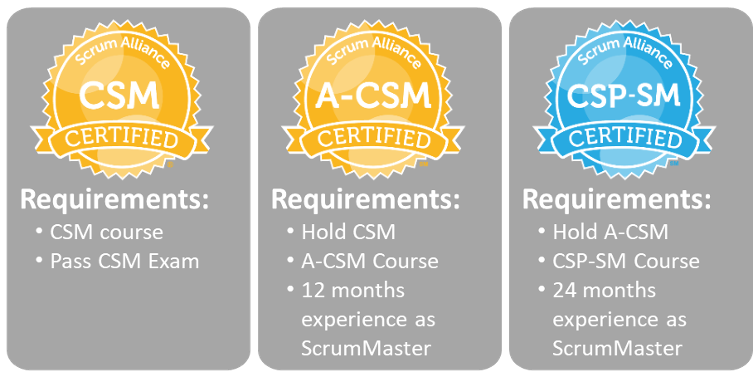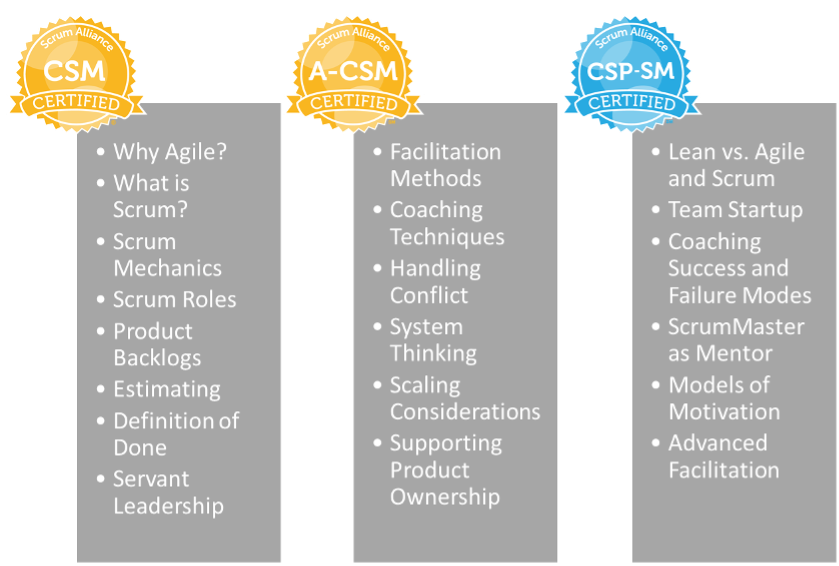Why were A-CSM and CSP-SM created?
Created by the Scrum Alliance and started in 2002, the Certified ScrumMaster (CSM) credential was the first ever professional Agile certification, and quickly became the most recognized and sought after validation of an individual’s understanding of Agile methods. In the almost 20 years since, the global community of CSMs has grown dramatically, and as of this writing nearly 1,000,000 people actively hold a CSM credential. But the CSM has always been essentially a foundation-level certification: being a CSM means you’ve attended a CSM class and passed an exam that’s intended to be a straightforward test of your understanding of the basics. CSM courses are intended to cover the features of Agile development writ-large, the assumptions and mechanics of the Scrum framework, and responsibilities and behaviors of the Scrum roles.
Recognizing a significant demand from learners and organizations for training and skills validation that goes deeper than a surface-level understanding, the Scrum Alliance expanded their certifications into tracts for each Scrum role (ScrumMaster, Product Owner, and Developer). CSM was now the first step in a journey, followed by Advanced Certified ScrumMaster (A-CSM), and finishing with Certified Scrum Professional – ScrumMaster (CSP-SM). Where CSM certification covers the basics, A-CSM provides a deeper dive into specific skills and methods one needs to succeed as a ScrumMaster, and CSP-SM requires demonstrating mastery not just of Scrum, but of the core behaviors and concepts that underlie Scrum and all Agile approaches.
What it takes to become A-CSM and CSP-SM
The requirements to become a CSM are straightforward: 1) Complete a Certified ScrumMaster course taught by one of the less than 300 Certified Scrum Trainers in the world and 2) pass the standardized 50-question CSM exam with a score of at least 74% correct. Above CSM, the other credentials in the ScrumMaster track require additional training and swap out exam requirements for documented experience in the ScrumMaster role.
To receive the A-CSM credential, an applicant must 1) hold an active CSM credential, 2) complete an Advanced – Certified ScrumMaster course taught by one of 150-or-so “Path to CSP Educators” in the world (a subset of the Scrum Alliance Guide community), and 3) document at least 12 total months of time working as a ScrumMaster on Scrum teams within the last 5 years.
To become a CSP-SM, an applicant must 1) hold an active A-CSM credential, 2) complete a Certified Scrum Professional – ScrumMaster course taught by a “Path to CSP Educators,” and 3) document at least 24 total months of time working as a ScrumMaster on Scrum teams within the last 5 years.

What you’ll learn becoming A-CSM or CSP-SM
Attaining the CSM is all about showing that you know the basics of Scrum, while the A-CSM is about expanding your toolkit, and the CSP-SM is about demonstrating significant mastery of skills, knowledges, and mindsets. So while in a CSM course you might learn that being a good facilitator is crucial skill for a ScrumMaster, in a A-CSM you would explore a host of facilitation techniques and consider how they might be used to avert anti-patterns on a team. In a CSP-SM course, you’d demonstrate your experience employing those techniques (especially in circumstances of high complexity). All Path to CSP Educators are required to meet the stated learning objectives for each course set out by the Scrum Alliance, though how those objectives are met variesfrom one educator to the next. At NextUp Solutions, a comparison of high-level topics by course looks like this:
What being A-CSM or CSP-SM tells others about you
Becoming a Certified ScrumMaster is a great way to start your Agile journey. But despite its prevalence and market desirability, being a CSM doesn’t actually tell people much about what you know about Scrum or your abilities as a ScrumMaster. Anyone who’s ever been in the position of trying to hire experienced ScrumMasters or Agile coaches will tell you there are lot of people out there who are CSMs but who’ve never actually done Scrum in any capacity (let alone the critical role of ScrumMaster). In becoming an Advanced-Certified ScrumMaster, you’re demonstrating that you haven’t just been to a class and passed a test: you’ve done this before, and you’ve done it enough to understand some of the patterns that help – and hurt – Scrum teams. And in achieving the Certified Scrum Professional – ScrumMaster, you’re not rounding out your ScrumMaster and Agile Coaching education, you’re demonstrating a degree of experience and content mastery that very few people will reach.
If you’re looking to distinguish yourself in a large stack of resumes, here are some numbers that might help you out: worldwide, there are over 900,000 active CSMs, but around 14,000 A-CSMS. And there are less than 9,000 CSP-SMs! That is a significantly small pool of people to compete with for plum roles on teams doing exciting work. And in becoming a CSP-SM, you also open the door toward pursuing Scrum training or coaching as you vocation by someday joining the Scrum Alliance Guide Community as a Certified Scrum Trainer, Certified Enterprise Coach, or Certified Team Coach.
Our first CSP-SM course will be taught on Wednesday, September 8. Learn more about the requirements and register now.
